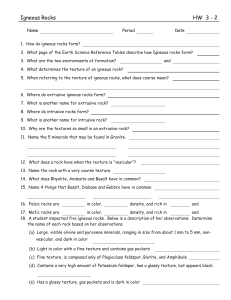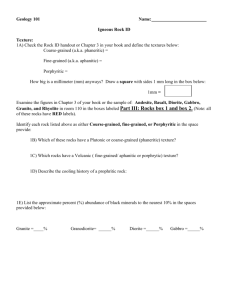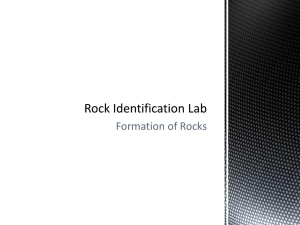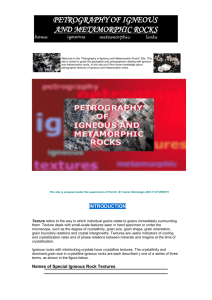Rock Identification Dichotomous Keys
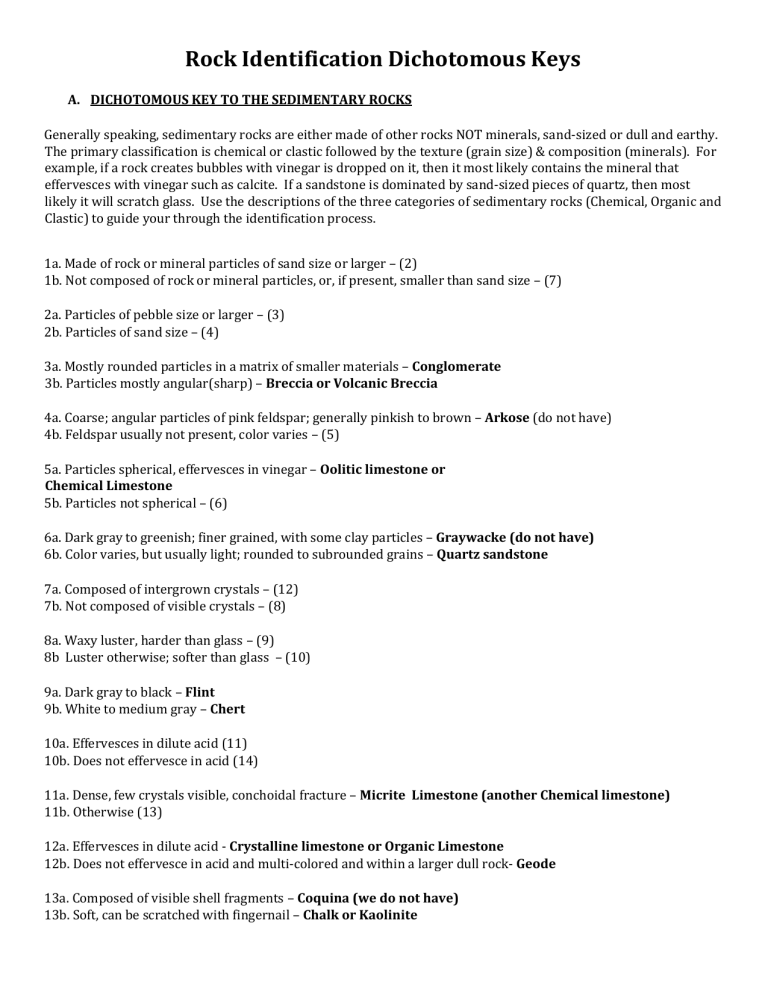
Rock Identification Dichotomous Keys
A.
DICHOTOMOUS KEY TO THE SEDIMENTARY ROCKS
Generally speaking, sedimentary rocks are either made of other rocks NOT minerals, sand-sized or dull and earthy.
The primary classification is chemical or clastic followed by the texture (grain size) & composition (minerals). For example, if a rock creates bubbles with vinegar is dropped on it, then it most likely contains the mineral that effervesces with vinegar such as calcite. If a sandstone is dominated by sand-sized pieces of quartz, then most likely it will scratch glass. Use the descriptions of the three categories of sedimentary rocks (Chemical, Organic and
Clastic) to guide your through the identification process.
1a. Made of rock or mineral particles of sand size or larger – (2)
1b. Not composed of rock or mineral particles, or, if present, smaller than sand size – (7)
2a. Particles of pebble size or larger – (3)
2b. Particles of sand size – (4)
3a. Mostly rounded particles in a matrix of smaller materials – Conglomerate
3b. Particles mostly angular(sharp) – Breccia or Volcanic Breccia
4a. Coarse; angular particles of pink feldspar; generally pinkish to brown – Arkose (do not have)
4b. Feldspar usually not present, color varies – (5)
5a. Particles spherical, effervesces in vinegar – Oolitic limestone or
Chemical Limestone
5b. Particles not spherical – (6)
6a. Dark gray to greenish; finer grained, with some clay particles – Graywacke (do not have)
6b. Color varies, but usually light; rounded to subrounded grains – Quartz sandstone
7a. Composed of intergrown crystals – (12)
7b. Not composed of visible crystals – (8)
8a. Waxy luster, harder than glass – (9)
8b Luster otherwise; softer than glass – (10)
9a. Dark gray to black – Flint
9b. White to medium gray – Chert
10a. Effervesces in dilute acid (11)
10b. Does not effervesce in acid (14)
11a. Dense, few crystals visible, conchoidal fracture – Micrite Limestone (another Chemical limestone)
11b. Otherwise (13)
12a. Effervesces in dilute acid - Crystalline limestone or Organic Limestone
12b. Does not effervesce in acid and multi-colored and within a larger dull rock- Geode
13a. Composed of visible shell fragments – Coquina (we do not have)
13b. Soft, can be scratched with fingernail – Chalk or Kaolinite
14a. Dense, shiny black, low specific gravity –Coal
14b. Otherwise (15)
15a. Fine-grained; fissile; color variable and usually has fossils – Shale
15b. Massive (not fissile) earthy luster – Mudstone (Siltstone/Claystone) we do not have
B.
DICHOTOMOUS KEY TO THE IGNEOUS ROCKS
Igneous rocks break-up into two categories, Volcanic (extrusive) or Magmatic (underground from magma- intrusive). In general Extrusive or volcanic rocks either have holes (created from the gases that are released during and eruption) and are light weight or can be glassy and sharp. Intrusive, cool slowly therefore can have small or large crystal (mineral grains- usually chunky minerals such as feldspars and quartz). Texture is largely related to the rate of cooling experienced by the rock. The more rapidly the magma cooled, the smaller the crystals formed and the finer the texture of the resultant rock.
Igneous Textures are: a) Glassy texture, the melt solidified before any crystals formed, consequently the very fine, shiny look of the rock. b) Vesicular texture is possessed of numerous holes. This is much like a form of glass or some finetextured rock. c) Aphanitic rocks have a fine texture because the rock cooled to a solid form before the crystals grew to visible size. These rocks look dull and more or less uniform, therefore, crystals cannot be seen. d) Phaneritic or coarse-textured rock, the cooling rate was sufficiently slow that visible crystals formed before the rock solidified. This gives the rock a crystalline appearance. Even when the crystals are small, they are still visible to the necked eye- such as Granite. e) Porphyritic texture result from a two-stage cooling process. They contain larger crystals
(phenocrysts) in a fine-textured matrix or groundmass.
Vesicular
1a. Vesicular texture - 2
Aphanitic
1b. Texture other than vesicular - 3
2a. Dark reddish brown to black in color - Scoria
2b. Light white to gray in color - Pumice
Phaneritic
3a. Glassy Texture - Obsidian
3b. Not glassy - 4
4a. Texture phaneritic (coarse) - 5
4b. Texture otherwise - 8
5a. Light colored, contains orthoclase - Granite
5b. Does not contain orthoclase - 6
6a. Mixture of light and dark crystals, orthoclase not evident - Diorite
6b. Dark minerals dominate - 7
7a. Hornblende and/or augite dominate - Gabbro
7b. Olivine the dominant mineral - Peridotite (we do not have)
Porphyritic
8a. Texture aphanitic (Fine-textured) - 9
8b. Texture porphyritic - 11
9a. Color dark gray to black - Basalt
9b. Color not as above - 10
10a. Light colored (Pink to cream to white) - Rhyolite
10b. Not as above (Brownish to greenish) - Andesite
11a. Light-colored matrix with phenocrysts – porphyritic Rhyolite (we do not have)
11b. Matrix not light colored - 12
12a. Dark gray to black matrix with phenocrysts – porphyritic Basalt (we do not have)
12b. Gray to greenish matrix with phenocrysts – porphyritic Andesite (we do not have)
C.
DICHOTOMOUS KEY TO THE METAMORPHIC ROCKS
Metamorphic rocks consist of the altered remains of pre-existing rocks and minerals (usually flat and thin minerals like micas or calcite which reacts to vinegar). For example, if a rock effervesces with vinegar then it most likely it contains calcite (remember which rock contains calcite-rhombic mineral). If a quartzite is the product of altered quartz sandstone, then most likely it will scratch glass. Once again you will be using similar methods to identify the metamorphic rocks as you have the previous two rock laboratories and as always you will be identifying these rocks. The primary classification is by texture and is foliated or non-foliated.
1a. Foliated (minerals oriented in parallel or sub parallel arrangement) –
(2) 1b. Nonfoliated – (5)
2a. Visible mica flakes or minerals segregated into bands – (3)
2b. Fine texture, mica flakes not evident, minerals not segregated into bands (4)
3a. Minerals segregated into light and dark bands – Gneiss
3b. Foliations thinner than above; scaly appearance due to mica flakes – Schist
4a. Foliations close; rock splits along parallel plains; not sparkly or satiny – Slate
4b. Satiny sheen; foliations crenulated (wavy) – Phyllite
5a. Containing pebbles and granules; breaks through pebbles – Conglomerate
5b. Pebbles and granules not evident – (6)
6a. Crystalline; hard (scratches glass); somewhat shiny – Quartzite
6b. Soft (will not scratch glass) – (7)
7a. Dense, dark-colored, will not effervesce in dilute acid – Hornfels (we do not have this)
7b. Crystalline, color variable, effervesces in dilute acid - Marble

